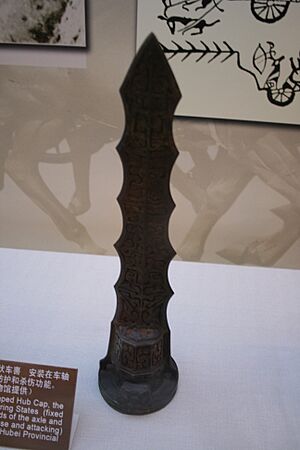Chariots in ancient China facts for kids
Quick facts for kids Chariots in ancient China |
|||||||
|---|---|---|---|---|---|---|---|
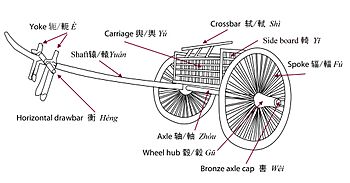
A Chinese chariot (c. 400 BCE)
|
|||||||
| Traditional Chinese | 戰車 | ||||||
| Literal meaning | war vehicle | ||||||
|
|||||||
The ancient Chinese chariot (traditional Chinese: 戰車; simplified Chinese: 战车; pinyin: zhànchē; literally "war vehicle") was a powerful war machine. It was used in ancient China on open fields and plains. These chariots first appeared around 1200 BCE. They helped military leaders move around the battlefield. Chariots also gave archers and soldiers with dagger-axes a fast way to fight. They were most important during the Spring and Autumn period. Later, cavalry (soldiers on horseback) largely replaced them during the Han dynasty.
Contents
History of Chinese Chariots
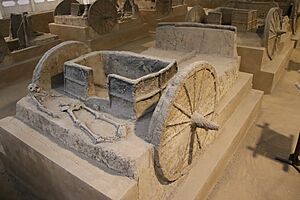
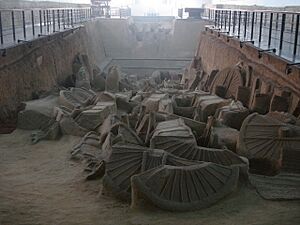
Some old stories say that a minister named Xi Zhong invented the chariot. They claim chariots were used in the Battle of Gan in the 21st century BCE. However, scientists have found proof that chariots began to be used around 1200 BCE. This was during the Late Shang period.
Chariots probably came to China from northern areas. These areas include the Deer stones culture. Ancient writings on oracle bone inscriptions show a two-wheeled vehicle. It had a single pole for attaching horses.
Chariots were very important weapons until the end of the Warring States period (471–221 BCE). After this, other fighting methods became more common. These included the crossbow, large groups of foot soldiers, and cavalry. Cavalry involved soldiers riding horses, especially for mounted archery.
Chariots still served as mobile command posts for officers. This was during the Qin and Han dynasties. Armored chariots were also used by the Han dynasty against the Xiongnu people. This happened in the Han–Xiongnu War. For example, at the Battle of Mobei in 119 CE, General Wei Qing used them. His army faced 80,000 Xiongnu cavalry. Wei Qing ordered his troops to form a ring with heavy-armored chariots. This created mobile fortresses.
Over time, warfare changed. Also, larger horses became more available. During the Qin and Han dynasties (221 BCE – 220 CE), cavalry and foot soldiers replaced chariots. The single-pole chariot became less important. A new type of chariot with two shafts developed. It was lighter and easier to handle for transport. During the Eastern Han (25–220 CE) and Three Kingdoms period (220–280 CE), this double-shaft chariot was common. Many Han dynasty stone carvings and tomb models show this change. The old war chariot from before the Qin period slowly disappeared.
How Ancient Chinese Chariots Were Built
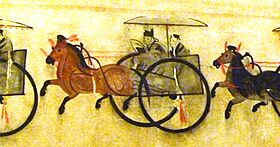
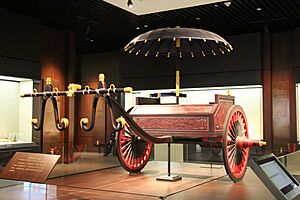
Ancient Chinese chariots usually had two wheels. They were pulled by two or four horses. A single pole, about 3 meters (10 feet) long, connected the horses to the chariot. This pole was first straight, but later became curved. At the front of the pole was a horizontal bar. It was about one meter (3 feet) long. Wooden yokes were attached to this bar to harness the horses.
The wooden wheels were about 1.2 to 1.4 meters (4 to 4.5 feet) wide. They were placed on an axle about 3 meters (10 feet) long. Bronze hubcaps secured the wheels. Shang period wheels usually had 18 spokes. Zhou period wheels had 18 to 26 spokes. Chariot wheels from the Spring and Autumn period (8th–7th century BCE) had 25 to 28 spokes.
The chariot's body was about one meter (3 feet) long and 0.8 meters (2.6 feet) wide. It had wooden walls. An opening at the back allowed soldiers to get in.
During the Spring and Autumn period (771–476 BCE), chariots improved. The curved pole's angle increased, lifting its end. This made it easier for horses to pull and increased the chariot's speed. The chariot body also became wider, about 1.5 meters (5 feet). This gave soldiers more room to move. Important parts like the pole, hubcap, and yoke were strengthened with decorated copper. This made the chariot more stable and durable. These improved chariots were called "gold chariots," "attack chariots," or "weapons chariots."
Chinese war chariots, like others in Eurasia, were fast. They had a light design. They also used horses, which were the fastest animals for pulling.
Chariot Crew and Weapons
A chariot usually carried three armored warriors. Each had a different job.
- The charioteer (yùzhě) drove the chariot.
- The archer (shè) shot arrows from a distance. Sometimes there were multiple archers (duōshè).
- The róngyòu (戎右) defended the chariot up close.
Weapons on the chariot included both close-combat and long-range tools.
The main close-combat weapon was the dagger-axe, or gē (戈). It had a shaft about three meters (10 feet) long. At the end, it had a sharp dagger on one side and an axe head on the other. The róngyòu carried this weapon. They could swing it or thrust it like a spear. By the Spring and Autumn period, the gē was mostly replaced by the halberd, or jĭ (戟). This weapon had a spear blade at the end of the shaft, plus the axe head and dagger.
All chariot commanders carried a bronze dagger. This was for protection if the chariot broke down or an enemy jumped on board. Soldiers wore leather or sometimes copper armor. They carried a shield, or dùn (盾), made from leather or bronze. The chariot's archer used either a bow (gōng 弓) or a crossbow (nŭ 弩) for long-distance attacks. Chariot horses also started wearing armor during the Spring and Autumn period. This protected them from injuries. When not fighting, chariots were used for transport.
How Chariots Were Used in Battle
The chariot was a large military vehicle. It was not very flexible on its own. So, a chariot commander usually had foot soldiers (tú zù) to help in battle. During the Western Zhou era, ten foot soldiers were usually assigned to each chariot. Five of them rode on the chariot. Each chariot with its soldiers was called a squadron (duì). Five squadrons made up a zhèngpiān. Four zhèngpiān formed a division (shī). Five divisions were known as an army (jūn).
In the Spring and Autumn period, the chariot became the main weapon. Armies grew larger. The number of chariots compared to the total army size decreased. The number of men assigned to each chariot increased to seventy. This change greatly affected how battles were fought.
Chariot Combat and Tactics

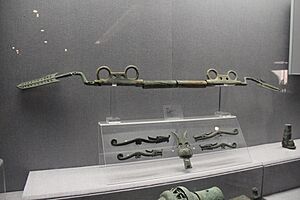
In ancient China, chariots were used as a main fighting tool. This was from the Shang dynasty until the early Han dynasty (around 1200–200 BCE). After that, cavalry replaced them, and chariots became a secondary support vehicle. For over a thousand years, chariot soldiers used special fighting tactics.
Chariot battles usually happened in wide, open areas. When two armies were close enough, they would first shoot arrows or crossbow bolts. They hoped to cause confusion in the enemy's lines. As the two sides got closer, they stayed about four meters (13 feet) apart. This avoided the 3-meter (10-foot) dagger-axes of their opponents. A real fight only happened when two chariots came closer than this.
Chariots were about three meters (10 feet) wide. Foot soldiers rode on both sides. This made them hard to turn. It also limited how weapons could be used. Opponents would look for quick chances to win. They might try to trap their enemy using a pincer movement (attacking from two sides). These tactics needed fighting in tight groups. They also needed good military discipline and control.
When the Spring and Autumn period began, armies paid more attention to formations. Chariot units were trained to work well with the rest of the army.
During the Western Zhou Era, chariots lined up side-by-side on wide plains. The foot soldiers were placed in front of the chariots. This wide formation stopped the enemy from attacking from the sides. When the two armies clashed, if the chariots stayed in strict formation, they could encircle the enemy. In this type of chariot warfare, orderly team fighting often decided who won. Otherwise, fighting had to stop to fix the formation.
Unified command was very important. Senior officers used drums and flags to tell the army to advance, retreat, speed up, or change formation. However, these operations were very slow. The speed of battle was limited. Also, foot soldiers had to stay in line. This made it hard to chase enemies who were running away.
A good example of disciplined forces is the Zhou overthrow of Shang. This happened at the Battle of Muye in 1046 BCE. As the Zhou army moved, foot soldiers and chariots were told to stop and regroup. They did this after every six or seven steps to keep their formation. The Shang army had more soldiers. But many were forced to fight and had low morale. As a result, their troops did not stay in formation and were defeated.
As the Spring and Autumn period began, chariots remained key to victory. At the Battle of Yanling in 575 BCE, the Chu and Jin states fought. The Chu army's chariots and foot soldiers were disorganized. This led to their defeat. After this, troop formations and chariot flexibility greatly improved. Foot soldiers played a much bigger role. Troops were no longer just in front of chariots. Instead, they were placed around all four sides. This made the chariot more flexible. Formations no longer used a single line of chariots. Instead, they were spread out, adding depth. This way, the chariot could move more freely. It could counter enemy attacks and chase retreating enemies quickly.
See also
- Chariot
- Horses in East Asian warfare
- South-pointing chariot
Images for kids


